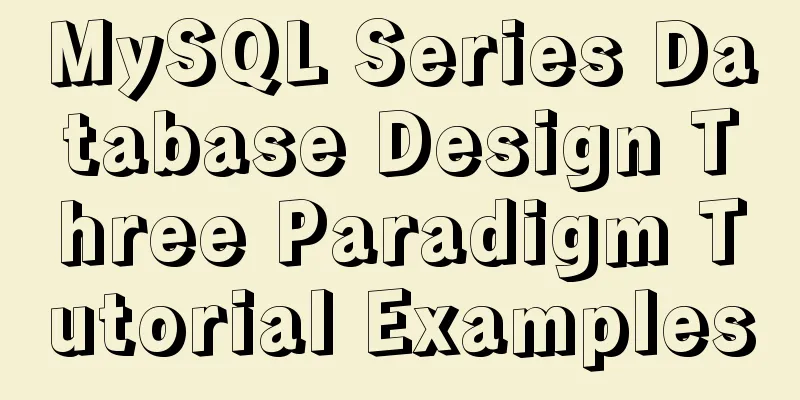MySQL Series Database Design Three Paradigm Tutorial Examples

1. Knowledge description of the three paradigms of database design1. What is a design paradigm?The basis for designing tables is that tables designed according to these three paradigms will not have data redundancy. 2. Why should we learn the three database paradigms?The database design paradigm is the specifications that the database design needs to meet. A database that meets these specifications is concise and has a clear structure. At the same time, no exceptions will occur in insert, delete, and update operations. On the contrary, it will be a mess, which will not only cause trouble for database programmers, but also be ugly and may store a lot of unnecessary redundant information. Although we data analysts do not need to design the database ourselves, understanding the three database paradigms can be helpful for our understanding of the tables later. 3. What are the three paradigms?1) First normal form: Any table should have a primary key, and each field should be atomic and indivisible.
2) Second normal form: It is based on the first normal form and requires that all non-primary key fields are completely dependent on the primary key and no partial dependency can occur.
Solution: Many-to-many, three tables, and two foreign keys in the relationship table.
3) Third normal form: built on the basis of the second normal form, all non-primary key fields directly depend on the primary key and cannot generate transitive dependencies.
Solution: One-to-many, two tables, add foreign keys to the multiple tables.
Note: Keep in mind the two sentences in blue above. Reminder: In actual development, the main focus is on meeting customer needs, and sometimes redundancy is traded for execution speed. 2. Classic design scheme of database tableHow to design one-to-one?The first solution: primary key sharing
The second solution: foreign key unique
Note: The unique foreign key situation is a bit like the many-to-many situation described above. When the foreign key field is added with a The above is the detailed content of the MySQL series of database design three paradigm tutorial examples. For more information about the MySQL database design three paradigms, please pay attention to other related articles on 123WORDPRESS.COM! You may also be interested in:
|
<<: A brief discussion on the difference between readonly and disable attributes of input in HTML
>>: Introduction to the steps of deploying redis in docker container
Recommend
Specific operations of MYSQL scheduled clearing of backup data
1|0 Background Due to project requirements, each ...
MySQL sharding details
1. Business scenario introduction Suppose there i...
Today I encountered a very strange li a click problem and solved it myself
...It's like this, today I was going to make a...
Solution to EF (Entity Framework) inserting or updating data errors
Error message: Store update, insert, or delete st...
WeChat Mini Program Basic Tutorial: Use of Echart
Preface Let’s take a look at the final effect fir...
Share some uncommon but useful JS techniques
Preface Programming languages usually contain v...
Six weird and useful things about JavaScript
Table of contents 1. Deconstruction Tips 2. Digit...
Sample code for implementing DIV suspension with pure CSS (fixed position)
The DIV floating effect (fixed position) is imple...
Detailed explanation of the use of css-vars-ponyfill in IE environment (nextjs build)
css-vars-ponyfill When using CSS variables to ach...
MySQL fuzzy query statement collection
SQL fuzzy query statement The general fuzzy state...
Design Theory: Text Legibility and Readability
<br />Not long ago, due to business needs, I...
Solution for using Baidu share on Https page
Since enabling https access for the entire site, ...
The vue configuration file automatically generates routing and menu instance code
Table of contents Written in front router.json Ro...
Analysis of the principles of Mysql dirty page flush and shrinking table space
mysql dirty pages Due to the WAL mechanism, when ...
The difference between z-index: 0 and z-index: auto in CSS
I've been learning about stacking contexts re...
















